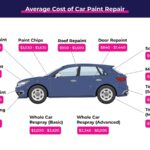Flood damage to a vehicle can range from minor inconveniences to catastrophic destruction. When water breaches the confines of your car, the immediate question that springs to mind is often, “Can this be fixed?” and more importantly, is it hard to repair a flooded car? The answer, unfortunately, isn’t a simple yes or no. Like diagnosing any complex automotive issue, repairing a flood-damaged car requires a thorough understanding of the type and extent of the water intrusion. Is it a matter of damp carpets and musty smells, or has the engine been submerged, leading to potential hydro-lock? The spectrum of flood damage is wide, and so is the difficulty and cost of repair.
To properly address whether it’s hard to repair a flooded car, we need to delve into the various aspects of flood damage. What exactly causes a car to become flood-damaged? What are the typical repair costs associated with such incidents? And crucially, is purchasing a flood-damaged vehicle ever a sound decision? Let’s explore these questions to provide a comprehensive understanding of the complexities involved in restoring a water-logged car.
How Cars Become Flood-Damaged: Understanding the Causes
Flooding events are increasingly common across the United States, stemming from severe storms, heavy rainfall, and overflowing bodies of water. While personal safety should always be paramount during these events, vehicles are often unfortunately caught in the deluge. Driving through flooded streets is a significant contributor to car flood damage. Attempting to navigate through high water can quickly overwhelm your vehicle’s defenses, allowing water to seep into areas it shouldn’t. The speed at which water infiltrates a car in such situations is often uncontrollable and surprisingly rapid.
Beyond driving through floods, even stationary cars can suffer extensive water damage. Leaving car windows or sunroofs open during a sudden downpour can lead to significant interior water accumulation. Even seemingly minor gaps or improperly sealed areas in a vehicle’s construction can become entry points for water during heavy rains, leading to hidden moisture buildup and subsequent issues like mold and mildew. Accidents involving water, such as losing control and ending up in a body of water, represent another severe scenario. In such cases, the damage can be particularly devastating, often rendering the car beyond economical repair.
One of the most critical forms of flood damage occurs when water enters the engine through the air intake. This can lead to a condition known as “hydro-lock,” where water incompressible nature causes severe internal engine damage. Hydro-lock is a significant risk when attempting to drive through flooded areas or even trying to move a car when water is rising around it. Understanding these various pathways to flood damage is the first step in appreciating the challenges associated with repair.
Decoding the Cost of Repairing a Flooded Car: Is It Economically Viable?
While technically almost anything can be repaired, the practical question with flood-damaged cars often boils down to economic viability. Repairing a car that has been extensively flooded, especially fully submerged, is a significant financial undertaking. Owners can face repair bills that can easily reach $12,000 or even exceed that figure, depending on the make, model, and extent of the damage. Lesser degrees of flooding will naturally result in lower repair costs, but even seemingly minor water intrusion can lead to hidden and costly problems down the line.
Insurance coverage plays a crucial role in determining the financial burden of flood damage repair. Unless a vehicle is covered by comprehensive insurance, flood damage repair costs typically fall entirely on the owner. Even with full coverage, there’s no guarantee of full financial relief. If the estimated repair costs exceed the car’s pre-flood market value, insurance companies are likely to declare the vehicle a total loss. In such cases, the car may be sent to a junkyard unless the owner opts to retain it, often with a significantly reduced payout.
If the flood damage is minimal or the car is relatively new, pursuing repairs might seem like a reasonable option. However, it’s crucial to understand a fundamental truth: a flood-damaged car will likely never be the same as it was before the incident. Water is insidious, and even after professional repairs, latent problems can emerge months or even years later. Electrical issues, persistent mold, and accelerated corrosion are just some of the potential long-term complications that can make the ongoing ownership of a repaired flood-damaged car a source of continuous expense and frustration.
Navigating the Risks: Is Buying a Flood-Damaged Car Ever Wise?
While some car dealers may skillfully restore flood-damaged vehicles to appear cosmetically appealing, the allure of a seemingly good deal should be approached with extreme caution. Buying a flood-damaged car is inherently risky, and potential buyers must be fully aware of the pitfalls. Key factors to consider include the duration of submersion and the type of water involved. Saltwater flooding is significantly more damaging than freshwater, leading to accelerated rust and corrosion throughout the vehicle’s components.
For buyers considering a flood-damaged car for short-term use or as a project for extensive rebuilding with new parts, it might represent a calculated risk. However, for most consumers seeking reliable transportation, purchasing a flood-damaged car is generally ill-advised unless the price reflects the inherent risks and potential future problems. Any vehicle that has been submerged should be priced substantially below its normal market value, and dealerships should provide transparent documentation of the restoration process.
It’s essential to remember that a flood-damaged car typically voids the manufacturer’s warranty. Furthermore, reselling a flood-damaged car can be extremely challenging due to its diminished market value and potential for hidden issues. A critical step in assessing a used car’s history is checking the vehicle title for “Salvage” or “Flood” stamps. These designations indicate that the vehicle has been declared a total loss by an insurance company due to flood or other severe damage, and while it may have been repaired, the underlying risks remain. These stamps serve as a significant red flag and should prompt deep consideration before proceeding with a purchase.
Selling Your Flood-Damaged Car: Exploring Your Options
If you find yourself with a flood-damaged car and the repair costs are prohibitive or your insurance company declares it a total loss, selling the vehicle as-is can be a practical solution. Instead of incurring potentially high and ongoing repair expenses, selling your flood-damaged car can provide a way to recoup some value and move forward.
Companies like SellMax specialize in purchasing damaged vehicles, including those with flood damage. Selling to such specialized buyers can streamline the process, offering a quick sale and often including free vehicle pickup. This can be a convenient and efficient way to dispose of a flood-damaged car, avoiding the complexities and uncertainties of private sales or extensive repair attempts. To assess the potential value of your flood-damaged vehicle and explore selling options, contacting specialized buyers like SellMax can provide a clear and straightforward path forward.
In conclusion, repairing a flooded car is indeed often hard, both in terms of the complexity of the technical repairs and the potential long-term financial implications. While repair may be technically possible, it’s essential to carefully weigh the costs, risks, and potential for future problems before making a decision. Understanding the full scope of flood damage and exploring all available options, including selling the vehicle, is crucial for making informed choices and mitigating the challenges associated with water-damaged cars.


